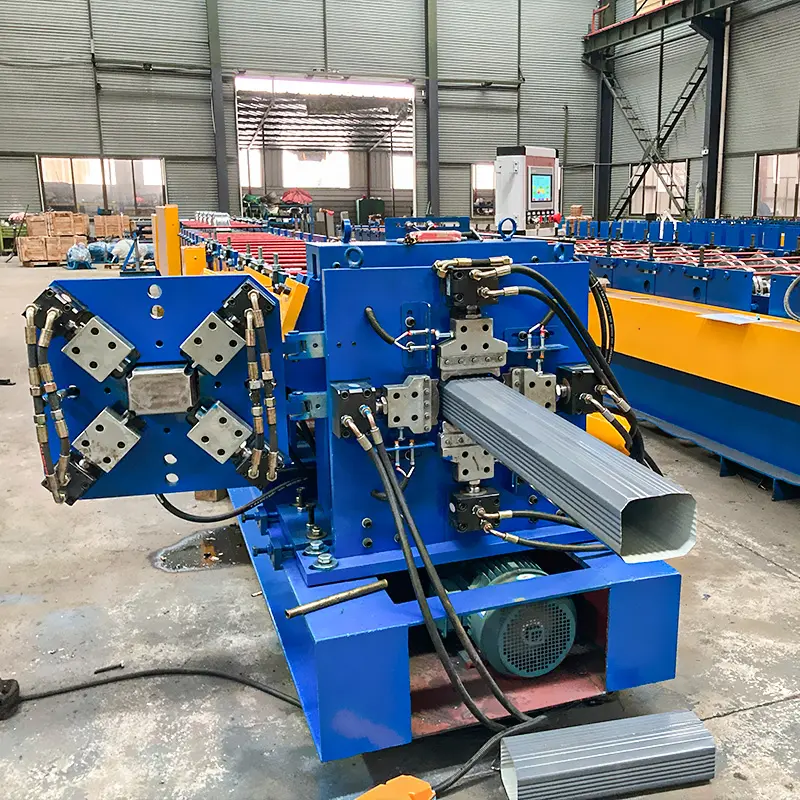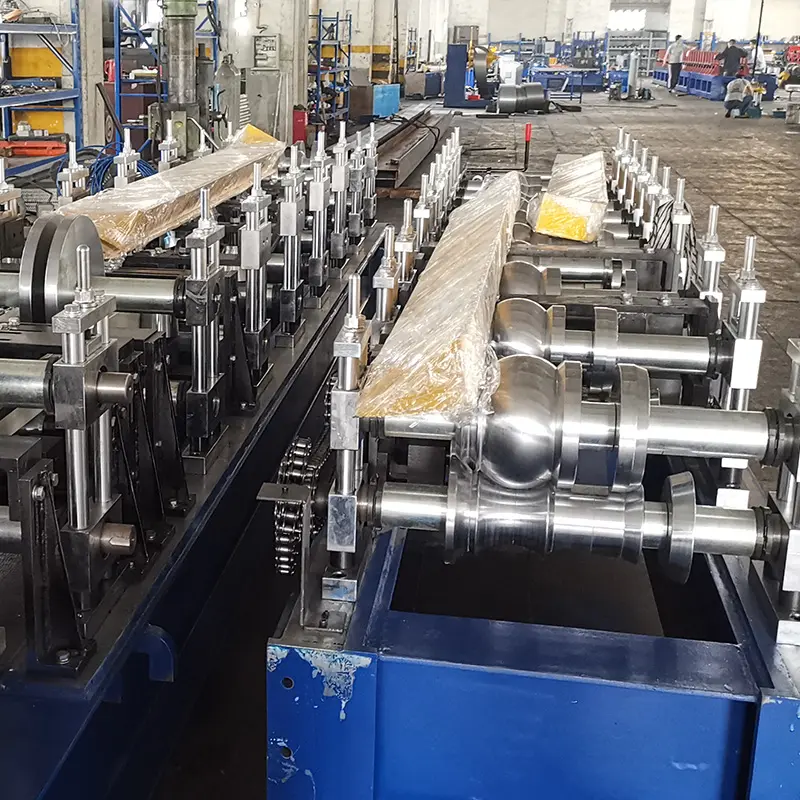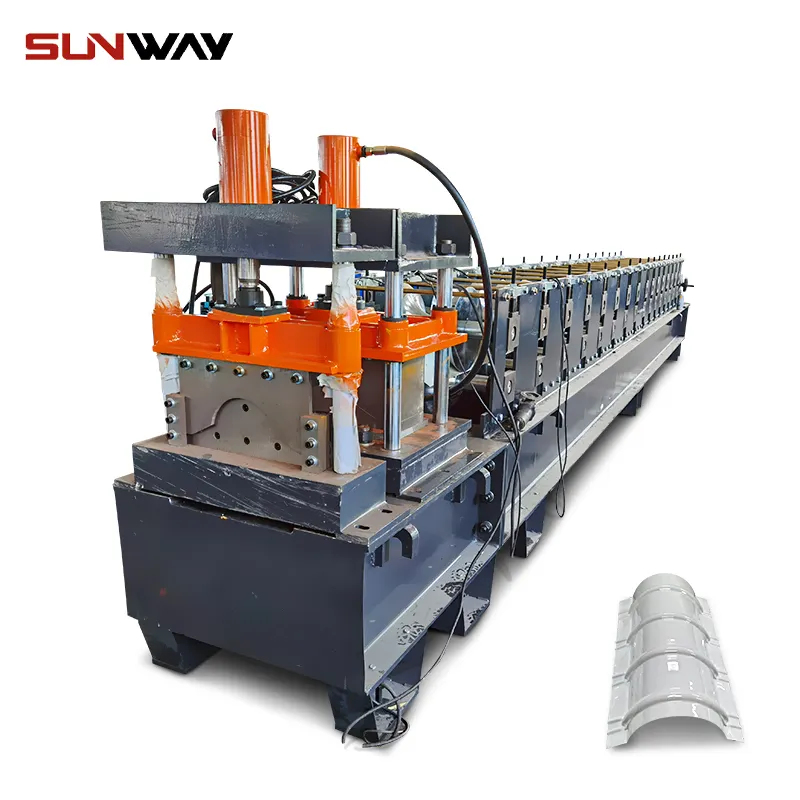परिचय
सीलिंग टी बार रोल फॉर्मिंग मशीनें निर्माण उद्योग में महत्वपूर्ण भूमिका निभाती हैं, जो निलंबित छतों में उपयोग होने वाले टी-आकार के बारों के कुशल और सटीक विनिर्माण को सक्षम बनाती हैं। ये मशीनें उत्पादन प्रक्रिया को स्वचालित करती हैं, समय और श्रम लागत बचाती हैं, और सुसंगत उच्च गुणवत्ता वाले परिणाम उत्पादित करती हैं। इस लेख में हम सीलिंग टी बार रोल फॉर्मिंग मशीनों की दुनिया में उतरेंगे, उनके घटकों, कार्य सिद्धांतों, लाभों और अपनी आवश्यकताओं के लिए सही मशीन चुनने के कारकों की खोज करेंगे।
सीलिंग टी बार रोल फॉर्मिंग मशीन को समझना
सीलिंग टी बार रोल फॉर्मिंग मशीनें धातु कॉइलों को टी-आकार के बारों में आकार देने के लिए डिज़ाइन की गई विशेष उपकरण हैं, जो वाणिज्यिक और आवासीय निर्माण परियोजनाओं में व्यापक रूप से उपयोग होते हैं। ये टी बार निलंबित छतों का कंकाल ढांचा बनाते हैं, छत टाइलों और अन्य घटकों के लिए समर्थन प्रदान करते हैं।

सीलिंग टी बार रोल फॉर्मिंग मशीनों के उपयोग के लाभ
बढ़ी हुई दक्षता और उत्पादकता
रोल फॉर्मिंग प्रक्रिया को स्वचालित करके, सीलिंग टी बार रोल फॉर्मिंग मशीनें दक्षता और उत्पादकता को काफी बढ़ाती हैं। पारंपरिक मैनुअल विधियों की तुलना में, जो समय लेने वाली और श्रम गहन हैं, रोल फॉर्मिंग मशीन का उपयोग तेज़ उत्पादन दरों और तेज़ परियोजना पूर्णता को सक्षम बनाता है।
सुसंगत और सटीक परिणाम
रोल फॉर्मिंग मशीन का उपयोग करने का एक प्रमुख लाभ टी बारों का सुसंगत
Efektivitas Biaya
Long-term savings from lower labor, waste, higher speed.
Components and Working Principle of Ceiling T Bar Roll Forming Machine
Essential parts synergize for T-bars.
डेकोइलर
डीकोइलर रोल फॉर्मिंग प्रक्रिया का प्रारंभिक बिंदु है। यह धातु कोइल को धारण करता है और मशीन में आगे की प्रक्रिया के लिए सामग्री को खिलाता है। डीकोइलर मैनुअल या स्वचालित हो सकते हैं, जो मशीन के स्वचालन स्तर पर निर्भर करता है।
Feeding System
फीडिंग सिस्टम धातु कोइल को रोल फॉर्मिंग यूनिट में सटीक रूप से निर्देशित करने के लिए जिम्मेदार है। यह सामग्री की स्थिर और निरंतर आपूर्ति सुनिश्चित करता है, जो सटीक टी बार प्रोफाइल प्राप्त करने के लिए आवश्यक है।
रोल फॉर्मिंग इकाई
रोल फॉर्मिंग यूनिट मशीन का हृदय है। इसमें एक श्रृंखला के रोलर और फॉर्मिंग डाई होते हैं जो धातु पट्टी को वांछित टी बार प्रोफाइल में क्रमिक रूप से आकार देते हैं। रोलरों की संख्या और कॉन्फ़िगरेशन विशिष्ट टी बार डिज़ाइन पर निर्भर करती है।
कटिंग सिस्टम
टी-बार प्रोफाइल बनने के बाद, कटिंग सिस्टम बार की लंबाई को वांछित आकार में ट्रिम कर देता है। कुछ मशीनों में फ्लाइंग या स्टेशनरी कटिंग सिस्टम होते हैं, जिनकी अपनी-अपनी विशेषताएं होती हैं।
PLC Control System
पीएलसी नियंत्रण प्रणाली मशीन का मस्तिष्क के रूप में कार्य करती है, जो पूरे रोल फॉर्मिंग प्रक्रिया की निगरानी और नियमन करती है। ऑपरेटर नियंत्रण पैनल के माध्यम से पैरामीटर इनपुट कर सकते हैं और समायोजन कर सकते हैं।

सीलिंग टी-बार प्रोफाइल के विभिन्न प्रकार
सीलिंग टी-बार रोल फॉर्मिंग मशीनें बहुमुखी होती हैं और विभिन्न निर्माण आवश्यकताओं को पूरा करने के लिए विभिन्न प्रकार की टी-बार प्रोफाइल उत्पादित कर सकती हैं। कुछ सामान्य प्रकार की टी-बार प्रोफाइल में शामिल हैं:
- मुख्य रनर: निलंबित छत प्रणाली की मुख्य संरचना बनाने वाला प्राथमिक टी-बार।
- क्रॉस टी: मुख्य रनरों के साथ प्रतिच्छेदित होने वाले छोटे टी-बार, जो छत टाइलों को समर्थन प्रदान करते हैं।
- वॉल एंगल: दीवारों के साथ चलने वाले एल-आकार के बार, जो निलंबित छत का परिधि बनाते हैं।
- शैडो लाइन: टाइलों के बीच सौंदर्यपूर्ण शैडो प्रभाव पैदा करने वाले विशेष टी-बार जिनमें धंसी हुई प्रोफाइल होती है।
सीलिंग टी-बार रोल फॉर्मिंग मशीन चुनते समय विचार करने योग्य कारक
इष्टतम प्रदर्शन और उत्पादकता सुनिश्चित करने के लिए सही सीलिंग टी-बार रोल फॉर्मिंग मशीन का चयन महत्वपूर्ण है। खरीदारी से पहले निम्नलिखित कारकों पर विचार करें:
उत्पादन क्षमता
अपनी परियोजना आवश्यकताओं के आधार पर आवश्यक उत्पादन क्षमता निर्धारित करें। गुणवत्ता से समझौता किए बिना वांछित उत्पादन को संभाल सकने वाली मशीन चुनें।
सामग्री संगतता
सुनिश्चित करें कि रोल फॉर्मिंग मशीन आपके उपयोग करने की योजना वाले धातु कॉइल के प्रकार और मोटाई के साथ संगत हो। विभिन्न मशीनें उन सामग्रियों को प्रभावी ढंग से संसाधित करने में सीमित हो सकती हैं।
Machine Size and Space Requirements
अपनी उत्पादन सुविधा में उपलब्ध स्थान पर विचार करें और उस स्थान में आराम से फिट होने वाली मशीन चुनें।
自动化功能
मशीन द्वारा प्रदान किए गए स्वचालन स्तर का मूल्यांकन करें। अधिक उन्नत स्वचालन सुविधाएँ उत्पादकता बढ़ा सकती हैं और मैनुअल हस्तक्षेप की आवश्यकता को कम कर सकती हैं।
छत टी बार रोल फॉर्मिंग मशीन का रखरखाव और समस्या निवारण
To ensure the longevity and reliable performance of your ceiling T-bar roll forming machine, regular maintenance is essential. Follow these guidelines:
नियमित रखरखाव
- स्नेहन: Keep all moving parts well lubricated to prevent wear and tear.
- Inspections: Conduct routine inspections to identify and address any potential issues.
- सफाई: Remove dust and debris from the machine regularly to maintain optimal performance.
सामान्य समस्याएं और समाधान
- Uneven T-Bar Profiles: Check for misaligned rollers and adjust them accordingly.
- Material Jamming: Ensure proper alignment and tension in the feeding system to avoid material jams.
- Inconsistent Cutting: Verify that the cutting system is functioning correctly and the blades are sharp.
Safety Precautions When Operating the Machine
Safety should be a top priority when operating a ceiling T-bar roll forming machine. Implement the following precautions to protect operators and prevent accidents:
- Training: Provide comprehensive training to operators on how to use the machine safely.
- Safety Guards: Install appropriate safety guards to protect operators from moving parts.
- Emergency Stop: Ensure an easily accessible emergency stop button on the machine.
- Personal Protective Equipment: Require operators to wear appropriate PPE, such as gloves and safety glasses.
Future Trends in Ceiling T-Bar Roll Forming Technology
As technology advances, ceiling T-bar roll forming machines are likely to incorporate more sophisticated features. Some potential future trends include:
- उन्नत स्वचालन: Further automation and integration with smart systems to optimize production processes.
- Material Innovation: Compatibility with a broader range of materials, including eco-friendly options.
- Real-Time Monitoring: Sensors and analytics to monitor machine performance and detect issues proactively.

निष्कर्ष
Ceiling T-bar roll forming machines have revolutionized the construction industry by streamlining the production of T-shaped bars used in suspended ceilings. These machines offer numerous benefits, such as increased efficiency, consistent results, and cost-effectiveness. When choosing a roll forming machine, consider factors like production capacity, material compatibility, and automation features. Proper maintenance and adherence to safety precautions are vital for the smooth operation and longevity of the machine. As technology continues to evolve, we can expect exciting innovations in ceiling T-bar roll forming technology, making construction processes even more efficient and sustainable.
常见问题解答
11.1 How long does it take to set up the machine?
The setup time for a ceiling T-bar roll forming machine can vary depending on the specific model and complexity of the project. However, with proper training and experience, setup times can be minimized.
11.2 Can the machine produce customized T-bar profiles?
Yes, many modern ceiling T-bar roll forming machines can be adjusted to produce customized T-bar profiles to meet specific project requirements.
11.3 What materials can be used with this machine?
Ceiling T-bar roll forming machines are designed to work with various materials, including galvanized steel, stainless steel, and aluminum.
11.4 Is it possible to adjust the machine for different sizes of T-bars?
Yes, most ceiling T-bar roll forming machines are equipped with adjustable rollers and forming dies, allowing for easy customization of T-bar sizes.
11.5 How can I ensure the safety of the operators during machine operation?
To ensure operator safety, provide comprehensive training, install safety guards, have an accessible emergency stop button, and require the use of appropriate personal protective equipment (PPE).
